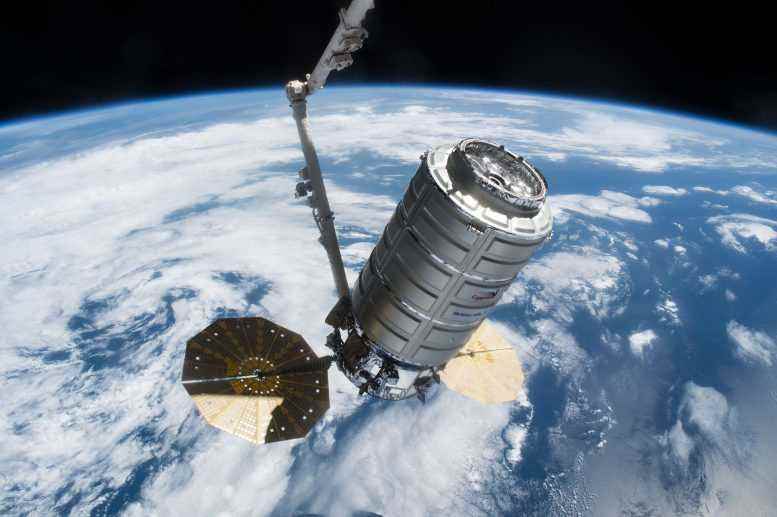Cygnus uzay gemisi. Kredi bilgileri: NASA
Oksijen üretimi, piller ve büyüyen bitkiler için teknoloji testleri ile birlikte cilt yaşlanması ve tümör hücreleri üzerindeki bilimsel araştırmalar, tümü Uluslararası Uzay İstasyonuna giden 17. Northrop Grumman ticari ikmal hizmetleri misyonunda seyahat ediyor. Cygnus uzay aracının 19 Şubat 2022 Cumartesi gününden daha erken bir tarihte havalanması planlanıyor.[{” attribute=””>NASA’s Wallops Flight Facility on Wallops Island, Virginia.
Here are details on some of the scientific investigations traveling to the space station on this mission:
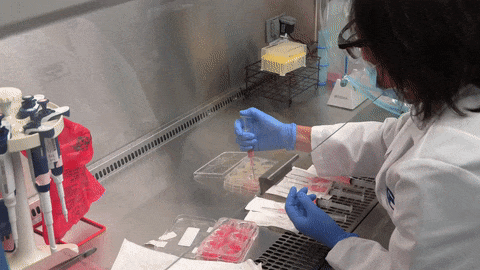
Preparation of tissue culture plates for Colgate Skin Aging, which evaluates changes in skin cells in microgravity and could help provide a model for assessing products for protecting skin from the effects of aging. Credit: Colgate-Palmolive
Protecting our skin
Deterioration of skin tissue, a normal part of aging, occurs over decades. Microgravity leads to changes in the body that are similar to aging but happen much more quickly in space where it can be more easily studied than on Earth. The Colgate Skin Aging experiment evaluates cellular and molecular changes in engineered human skin cells in microgravity. Aging-related skin changes are not simply cosmetic. As the body’s largest organ, skin performs multiple functions, including protection from infection, regulation of body temperature, and sensory input. Loss of functional or structural stability in skin therefore can be a potential source of other health problems. Results from this experiment could show that these engineered cells may serve as a model to rapidly assess products aimed at protecting skin from the aging process back on Earth.
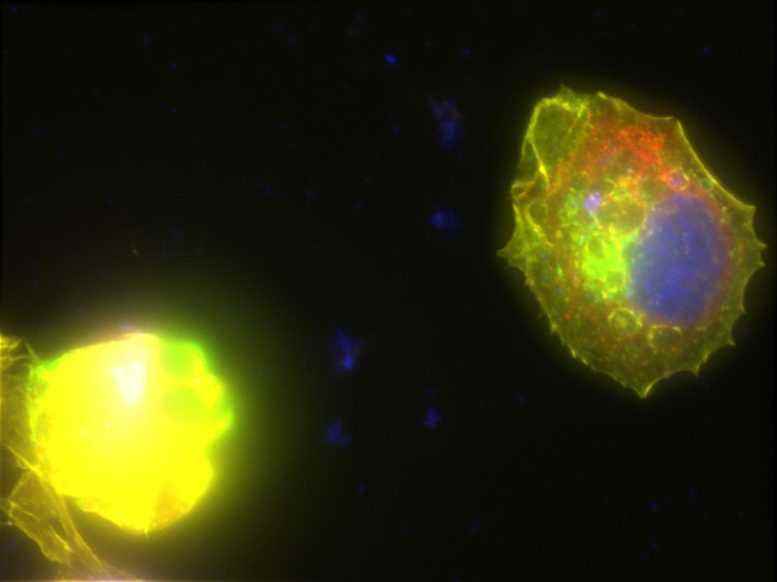
This image shows immunofluorescence of breast cancer cells treated with a MicroQuin therapeutic. Staining shows a normal nucleus (blue) and the therapeutic (green) localized to the cell’s endoplasmic reticulum (red). The drug forces the cytoskeleton (yellow) to collapse, inducing cell death. Credit: Scott Robinson, MicroQuin
Testing tumor drugs
MicroQuin 3D Tumor examines the effects of a drug on breast and prostate cancer cells in space. In microgravity, these cells can grow in a more natural three-dimensional model, which makes it easier to characterize their structure, gene expression, cell signaling, and response to the drug. Results could provide new insight into the cell protein targeted by the drug and help advance development of other drugs that target cancerous cells.
“Our 3D tumor modeling investigation on the space station provides a phenomenal opportunity to study cancer more naturally, allowing us to better assess drug penetration, tumor response, cell-to-cell signaling, disease progression, and even how drug resistance can emerge,” says Scott Robinson, MicroQuin principal investigator. “Cancerous cells ignore signals to stop growing, stop dividing, or even to die. In microgravity, these signals change considerably and can either benefit or hinder cancer growth. Knowing what signaling pathways are affected and how, allows us to focus research efforts on defining new therapeutic interventions that are more effective, less toxic, and have better patient outcomes.”
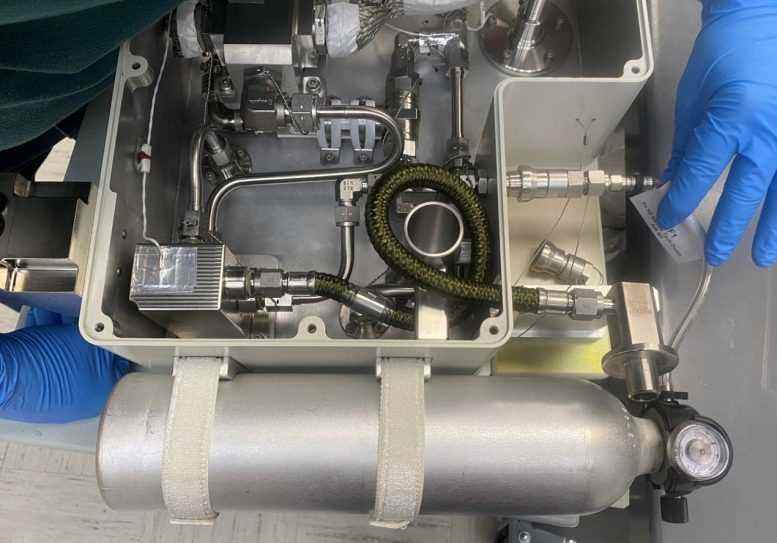
Hardware for the OGA H2 Sensor Demo shown in preparation for flight. This technology demonstration tests new sensors for detecting hydrogen in oxygen generating systems on spacecraft. Credit: NASA’s Marshall Space Flight Center
Improving hydrogen sensors
The OGA H2 Sensor Demo tests new sensors for the space station’s oxygen generation system (OGS). The OGS produces breathable oxygen via electrolysis, or separation of water into hydrogen and oxygen. The hydrogen is either vented overboard or sent to a post-processing system where it is recombined with waste carbon dioxide to form water. Current sensors ensure that none of the hydrogen enters the oxygen stream into the cabin, but are sensitive to moisture, nitrogen, drift in calibration, and other issues that can cause problems. They must therefore be swapped out after every 201 days of use.
This technology could provide more durable sensors for situations where replacement is not practical every 201 days, reducing the number of spares needed on longer space missions such as to the Moon or Mars. Improved technology for monitoring oxygen generation systems also has potential applications in contained environments on Earth, such as underwater facilities and those in remote and dangerous locations.
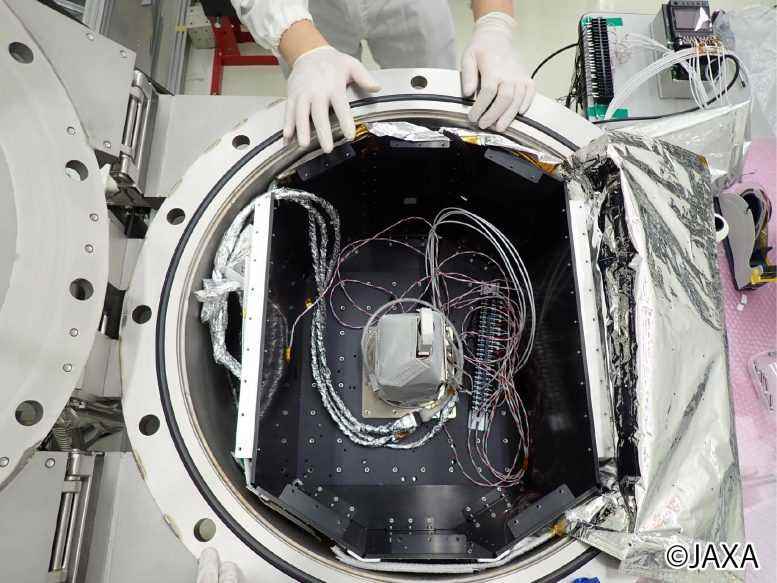
The Space As-Lib hardware is shown undergoing thermal vacuum testing prior to launch. Credit: JAXA
Better batteries
An investigation from the Japan Aerospace Exploration Agency (JAXA), Space As-Lib demonstrates operation of a lithium-ion secondary battery capable of safe, stable operation under extreme temperatures and in a vacuum environment. The battery uses solid, inorganic, and flame-retardant materials and does not leak liquid, making it safer and more reliable. Results could demonstrate the battery’s performance for a variety of potential uses in space and other planetary environments. Solid-state batteries also have potential applications in harsh environments and in the automotive and aerospace industries on the Earth.
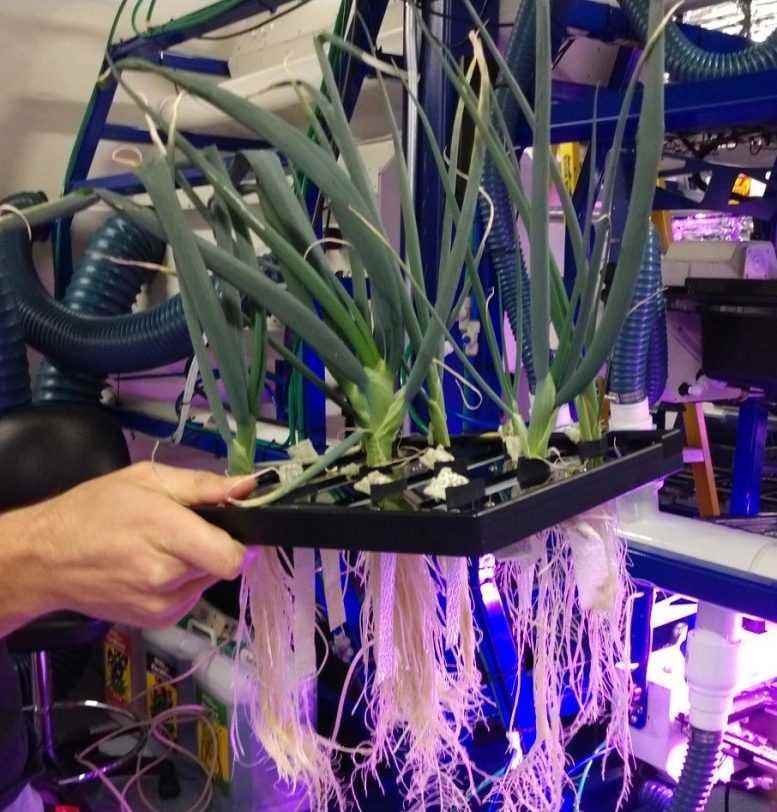
Green onion plants grown using aeroponics are held to display their roots. The XROOTS study tests hydroponic (water-based) and aeroponic (air-based) techniques to grow plants in space. Credit: Sierra Space
Plants in space
Current systems for growing plants in space use soil or a growth medium. These systems are small and do not scale well in a space environment due to mass and containment, maintenance, and sanitation issues. XROOTS tests using hydroponic (water-based) and aeroponic (air-based) techniques instead, which could reduce overall system mass. The investigation takes video and still images of root zone and crops for evaluation of the plant life cycle from seed germination through maturity in multiple independent growth chambers.
“The investigation incorporates unique Root Modules designed to provide delivery and recovery of nutrient solution to the plants so they can be grown without the additional mass of any soil media,” explains principal investigator John Wetzel of Sierra Nevada Corporation. “This approach is much more mass efficient for future large-scale plant growth systems in space.”
Results could provide insight into the development of larger scale systems to grow food crops for future space exploration and habitats. Components of the system developed for this investigation also could enhance cultivation of plants in terrestrial settings such as greenhouses and contribute to better food security for people on Earth.
Yangın güvenliğinin iyileştirilmesi
Katı Yakıt Tutuşturma ve Söndürme (SoFIE) tesisi, malzemelerin yanıcılığı ve yangınların tutuşturulması ile ilgili çalışmalara gerçekçi atmosfer koşullarında olanak sağlar. Yanma Entegre Rafını kullanır (CIR), mevcut ve planlanan uzay araştırma görevlerini temsil eden farklı oksijen konsantrasyonlarında ve basınçlarında test yapılmasını sağlar. Yerçekimi, Dünya’daki alevleri etkiler; ancak uzay istasyonundaki mikro yerçekiminde, ateş farklı davranır ve beklenmedik şekillerde davranabilir. Bazı kanıtlar, gelecekteki uzay görevleri için bir güvenlik endişesi olan düşük yerçekiminde yangınların daha tehlikeli olabileceğini düşündürmektedir.
Sonuçlar, uzay uçuşu malzemelerinin ve modellerinin yanıcılığını tahmin etmek için test yöntemleri ve modelleri doğrulamaya yardımcı olarak, yangınların azaltılmış yerçekiminde nasıl başladığını ve büyüdüğünü anlamayı iyileştirebilir. Bu içgörü, araç dışı aktivite kıyafetlerinin tasarımını geliştirerek, daha güvenli kabin malzemeleri seçimini bildirerek ve uzayda yangınları bastırmak için en iyi tekniklerin belirlenmesine yardımcı olarak mürettebat güvenliğini sağlamaya yardımcı olabilir. Proje verileri ayrıca yangın güvenliğinin daha iyi anlaşılmasını sağlayabilir ve evler, ofisler, uçaklar ve Dünyadaki diğer kullanımlar için malzeme test etme yöntemlerini iyileştirebilir.

